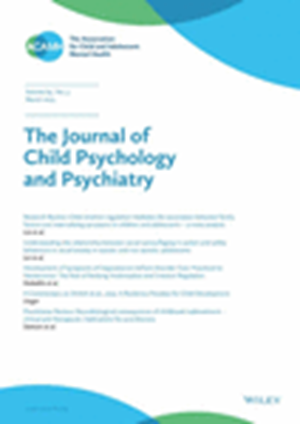精神兴奋剂治疗独特地降低了具有双相I型障碍家族性风险的ADHD青年左钩叶束微结构完整性:一项为期12周的DTI研究。
IF 7
1区 医学
Q1 PSYCHIATRY
引用次数: 0
摘要
双相I型障碍(BD)与钩侧束(UF)白质微结构完整性降低有关,钩侧束是连接额叶系统的初级纤维束。虽然双相障碍家族史、注意缺陷/多动障碍(ADHD)和精神兴奋剂是双相障碍病理的重要危险因素,但它们对UF微观结构的影响尚不清楚。方法:本弥散张量成像研究调查了患有双相障碍的一级亲属(“高风险”,HR)和未患有双相障碍的一级亲属(“低风险”,LR)的ADHD青少年在接受精神兴奋剂治疗前后12周的UF显微结构完整性。LR青年接受为期12周的开放标签混合安非他明盐缓释(MAS-XR), HR青年随机接受MAS-XR或安慰剂(PLA)。双侧UF分数各向异性(FA)和轴向扩散率(AD)采用自动纤维定量评估。结果共纳入137名受试者。基线时,两组间双侧UF显微结构指标无显著差异。经过12周的MAS-XR治疗,发现HR-MAS和LR-MAS之间的左UF FA和AD,以及HR-MAS和HR-PLA之间的左UF FA显着的组时间相互作用。其中,左UF FA和UF AD在HR-MAS组显著降低,但在LR-MAS组和HR-PLA组保持不变。在第12周,左UF FA在HR-MAS相对于HC较低,但在LR-MAS或HR-PLA中没有。节段分析进一步显示,HR-MAS组的UF微结构变化局限于前节段。这些结果表明,HR-ADHD青少年在接受精神兴奋剂治疗后,特别容易受到左UF微结构完整性降低的影响,这可能与双相障碍的发病进展有关。本文章由计算机程序翻译,如有差异,请以英文原文为准。
Psychostimulant treatment uniquely reduces left uncinate fasciculus microstructural integrity in ADHD youth with a familial risk for bipolar I disorder: a 12-week DTI study.
BACKGROUND
Bipolar I disorder (BD) is associated with reduced white matter microstructural integrity in the uncinate fasciculus (UF), a primary fiber tract connecting frontolimbic systems. Although familial history for BD, attention-deficit/hyperactivity disorder (ADHD), and psychostimulants are important risk factors implicated in BD pathoetiology, their impact on UF microstructure remains poorly understood.
METHODS
This diffusion tensor imaging study investigated UF microstructural integrity prior to and following 12 weeks of psychostimulant treatment in ADHD youth with ('high-risk', HR) and without ('low-risk', LR) a first-degree relative with BD. Healthy controls were included for comparative purposes. LR youth received 12-week open-label mixed amphetamine salts-extended release (MAS-XR), and HR youth were randomized to either MAS-XR or placebo (PLA). Bilateral UF fractional anisotropy (FA) and axial diffusivity (AD) were assessed using automated fiber quantification.
RESULTS
A total of 137 participants were included in the analyses. At baseline, there were no significant group differences in bilateral UF microstructural metrics. Following 12-week MAS-XR treatment, significant group-by-time interactions were found for left UF FA and AD between HR-MAS and LR-MAS, as well as for left UF FA between HR-MAS and HR-PLA. Specifically, left UF FA and UF AD decreased significantly in HR-MAS but remained unchanged in LR-MAS and HR-PLA groups. At week 12, left UF FA was lower in HR-MAS relative to HC but not in LR-MAS or HR-PLA. Segment-wise analyses further revealed that UF microstructural changes in the HR-MAS group were localized to the anterior segments.
CONCLUSIONS
These results suggest that HR-ADHD youth are uniquely vulnerable to reductions in left UF microstructural integrity following psychostimulant treatment, suggesting potential relevance to BD pathoprogression.
求助全文
通过发布文献求助,成功后即可免费获取论文全文。
去求助
来源期刊
CiteScore
13.80
自引率
5.30%
发文量
169
审稿时长
1 months
期刊介绍:
The Journal of Child Psychology and Psychiatry (JCPP) is a highly regarded international publication that focuses on the fields of child and adolescent psychology and psychiatry. It is recognized for publishing top-tier, clinically relevant research across various disciplines related to these areas. JCPP has a broad global readership and covers a diverse range of topics, including:
Epidemiology: Studies on the prevalence and distribution of mental health issues in children and adolescents.
Diagnosis: Research on the identification and classification of childhood disorders.
Treatments: Psychotherapeutic and psychopharmacological interventions for child and adolescent mental health.
Behavior and Cognition: Studies on the behavioral and cognitive aspects of childhood disorders.
Neuroscience and Neurobiology: Research on the neural and biological underpinnings of child mental health.
Genetics: Genetic factors contributing to the development of childhood disorders.
JCPP serves as a platform for integrating empirical research, clinical studies, and high-quality reviews from diverse perspectives, theoretical viewpoints, and disciplines. This interdisciplinary approach is a key feature of the journal, as it fosters a comprehensive understanding of child and adolescent mental health.
The Journal of Child Psychology and Psychiatry is published 12 times a year and is affiliated with the Association for Child and Adolescent Mental Health (ACAMH), which supports the journal's mission to advance knowledge and practice in the field of child and adolescent mental health.

 求助内容:
求助内容: 应助结果提醒方式:
应助结果提醒方式:


